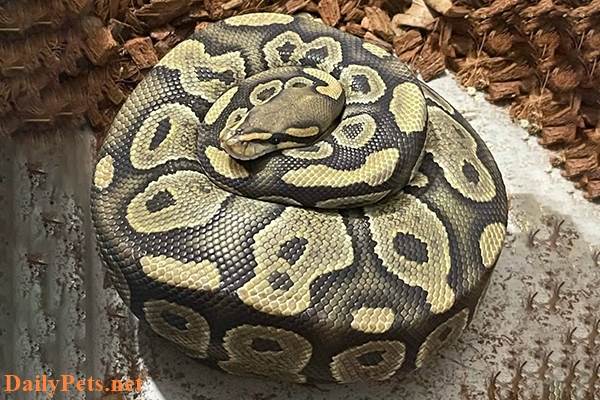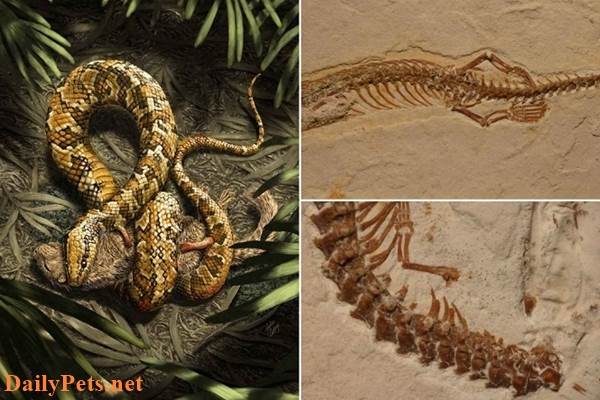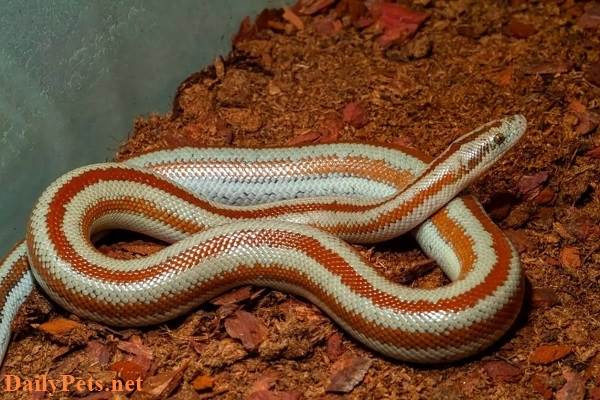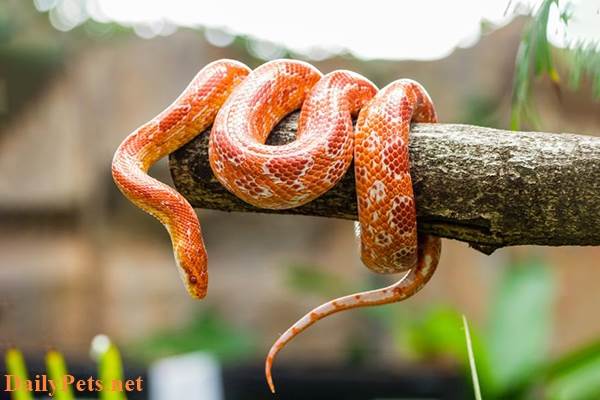Over the years, these pythons have become the most popular ornamental reptile in Western countries, especially the United States.
Join DailyPets.net to learn about the origin, characteristics, and care of Ball Python through this article.
Origin of Ball Python
The Ball Python, also known as the Royal Python, with the scientific name: Python regius, is a species of small python native to West and Central Africa.

A Ball Python.
Ball pythons live in many countries, such as Senegal, Mali, Guinea-Bissau, Guinea, Sierra Leone, Liberia, Ivory Coast, Ghana, Benin, Nigeria, Cameroon, and Chad, from the Central African Republic to Sudan and Uganda. They prefer grasslands and sparsely wooded areas.
Shape and color of Ball python
Purebred ball pythons are usually black or dark brown with pale spots on the back and sides. The abdomen is ivory white. The ball python is one of the reptiles with the most colorful hybrids in the world.

The head of the Ball Python is flat, with a square-shaped mouth with strong jaw muscles on either side. Eyes round and protruding outward. The neck is narrow and smaller than the head, gradually becoming fat in the abdomen. The python’s tail is short and tapered to the end.
The size and lifespan of the Ball Python
At birth, Ball pythons are 25 to 43 cm in length. The female python reached an average length from mouth to cloaca of 116.2 cm, a jaw length of 44.3 mm, a tail length of 8.7 cm, and a maximum weight of 1,635 kg. Male pythons are smaller, with an average mouth-to-vent length of 111.3 cm, a jaw length of 43.6 mm, a tail length of 8.6 cm, and a maximum weight of 1,561 kg.
With proper care, Ball pythons can live for 30 years or more. The record age of the ball python is more than 40 years.
Ball Python personality traits
Ball pythons are an ideal pet because of their relatively small size and gentle nature. They have defensive behavior by curling up and hiding their head inside like a ball, hence their name, Ball Python.
Ball pythons are very good climbers, preferring to hide in other animals’ burrows or underground. Pythons tend to fast when the weather turns cold; the temperature is not enough to help them digest food.
Habitat of Ball Python
Ball pythons can adapt to several different habitats if necessary. But their preference is still grasslands, sparsely wooded areas, and savannas.
Female Ball pythons (usually larger and heavier than males) prefer to live on the ground. The smaller males live in semi-vegetative habitats, which means they spend part of their time in trees and partly on the ground. Ball pythons are most active at dawn and dusk.
Ball python reproduction
Ball pythons breed from September to November every year and lay 3-11 eggs in the burrow. Female pythons incubate by curling around eggs. Eggs hatch after 55 – 60 days. Young male pythons reach sexual maturity at 11-18 months, and female pythons at 20-36 months.
When newly laid, python eggs will be slightly sticky. The eggs will lose their stickiness as they prepare to hatch.
How to take care of Ball Python
For Ball pythons to grow well and be healthy, pet owners need to understand the characteristics of pythons so that they can design an ideal living environment, suitable and as close to nature as possible, besides providing a suitable, healthy diet for them.
Ball python cage
Ball pythons are great pets because they are small, easy to keep, and have a gentle, docile temperament. For Python to develop in the best way, the preparation of a reasonable cage is indispensable.
You can make a cage for Python Ball with many different materials such as glass, wood, or plastic, but you must ensure the following factors:
- There should be plenty of ventilation holes around the cage or tank.
- The cage size should be comfortable, preferably twice the size of the Ball python. Approximately 50x27x30 cm (L x H x Width) for a baby Ball python.
- In the cage, there must be a suitable lining; you can use newspaper, coconut mulch, or other types of lining such as Forest Floor, pine bark, …
- A cup of clean water is indispensable in the Royal Python cage, helping the Python drink water and increase humidity. The water bowl should be made of stone or porcelain to not tip over into the barn.
- Python Ball’s cage must be made carefully and not have too large openings because the Python will easily crawl out and go away.
Temperature & Light
Ball pythons are carnivorous reptiles that need a heat source to digest and absorb edible food. Python will stop eating, vomiting food when the temperature drops too low.
The best temperature to help pythons digest food is 32 – 33 degrees Celsius. The cool area in the cage is about 24-26 degrees Celsius. Around the cage is about 27 degrees Celsius. You can use a heater or a heat mat. to create a temperature range for the Python.
Pythons also do not need special light like UVB, but you must still provide light to help the python distinguish day and night. Cycles of 12 hours of light and 12 hours of darkness are best, helping to simulate the python’s habitat.
Food & Water for Ball Pythons
Ball pythons are carnivores; their favorite food is small animals such as mice, birds, … In the process of being kept in captivity, frozen mice are the most suitable food for Ball pythons because they have many sizes. Size and won’t hurt your Python.
In the python’s cage, it is always necessary to have a cup of clean water for the python to drink and soak in. The ideal humidity in the cage should be at 50 – 60% and increase to about 65% when the pythons shed their skin.
Common diseases in Ball python
The Ball python is an animal with good health and usually does not suffer from many diseases. With a correct menu, building a stable, appropriate temperature and humidity will help Python not be stressed and avoid health problems.
Some problems you should pay attention to when raising pythons are incomplete molting, mites, and respiratory diseases:
- Incomplete molting: Providing adequate water and moisture in the cage will make it easier for Pythons to molt.
- Ticks: Please clean the cage regularly to prevent parasites for Pythons.
- Respiratory disease: Usually caused by extreme cold, pythons will stop eating and have foam in their mouths. Take the python to the vet when this is the case.
How much does Ball Python cost?
The Ball Python is one of the most numerous ornamental reptiles in the world. According to Wikipedia statistics, there are currently more than 6,500 different variations of the Ball Python in the world, and breeders are constantly creating new forms.
The price of Ball Python is, therefore, very diverse, ranging from $100 to $5000, depending on the rarity and beauty of each variant.





